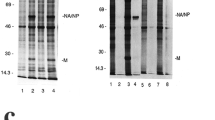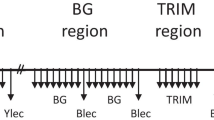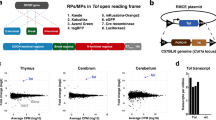Abstract
The immune response to the liver protein F antigen which, in the mouse, occurs in two allelic forms, is under sharp immunogenetic control in that only mice that possess the Ak molecule can respond to allo-F antigen. This response has been studied in a number of F1 hybrids between inbred strains and with recombinant inbred lines all of which express Ak, and which thus enable immune suppression effects to be detected. In the AKXL and AKXD sets, the hybrids with CBA are responders if H-2 k/H-2k, and usually nonresponders if H-2 k/H-2b or H-2 k/H-2d. Although this may be due to gene dosage effects, this cannot be the explanation for the low responsiveness of the H-2 k/H-2b relative to the H-2 k/H-2d mice found in CBA × BXD hybrids. For this, and other reasons, it seems likely that low responsiveness in any mouse possessing a responder A k allele is due to suppression, and that this is mediated by the immune suppression effects of the non-H-2 k haplotype. These H-2-mediated effects can be modified, both positively and negatively, by background genes. Thus, of the ten H-2k/H-2d members of the CBA × AKXD cross, seven are low responders and three are high responders. No other typed marker has the same strain distribution pattern at present. Major unresolved questions, therefore, concern the location and mechanism of action of the background genes and the mechanism of action of the H-2 immune suppression genes.
Similar content being viewed by others
References
Baxevanis, C. N., Ishii, N., Nagy, Z. A., and Klein, J.: Role of the Ek molecule in the generation of suppressor T cells in response to LDHB. Scand. J. Immunol. 16: 25–31, 1982
Beller, D. L.: Functional significance of the regulation of macrophage la expression. Eur. J. Immunol. 14: 138–143, 1984
Bogen, B.: Dominant suppressive effect of the silent E bα allele on an in vivo T helper response under E Emphasis>/dβ E dα region-linked immune response gene control. Eur. J. Immunol. 15: 1033–1037, 1985
Bolton, A. E. and Hunter, W. M.: The labelling of proteins to high specific radioactivities by conjugation to a 125I-containing acylating agent. Biochem. J. 133: 529–539, 1973
Cinader, B., Koh, S. W., and Naylor, D.: Tolerance-mediated inheritance of immune responsiveness. Int. Arch. Allergy Appl. Immunol. 35: 150–162, 1969
Cooper, P. C., Coffey, M. F., Anders, R. F., and Mackay, I. R.: Delayed-type hypersensitivity to liver F antigen in the mouse. J. Immunol. 124: 790–794, 1980
Debre, P., Kapp, J. A., and Benacerraf, B.: Genetic control of specific immune suppression. II. H-2-linked dominant genetic control of immune suppression by the random copolymer L-glutamic acid50-L-tyrosine50 (GT). J. Exp. Med. 142: 1447–1454, 1975
Ebringer, A., Deacon, N. J., and Young, C. R.: Codominant inheritance in immunogenetic (Ir-gene) systems. J. Immunogenet. 3: 401–409, 1976
Gasser, D. L.: Genetic control of the immune response in mice. I. Segregation data and localisation to the fifth linkage group of a gene affecting antibody production. J. Immunol. 103: 66–70, 1969
Holt, P. G., Britten, D., and Sedgwick, J. D.: Suppression of IgE responses by antigen inhalation: studies on the role of genetic and environmental factors. Immunology 60: 97–102, 1987
Jensen, P. E. and Kapp, J. A.: Genetics of insulin-specific helper and suppressor T cells in nonresponder mice. J. Immunol. 135: 2990–2995, 1985
Kelly, C. J. and Neilson, E. G.: Contrasuppression in autoimmunity. Abnormal contrasuppression facilitates expression of nephritogenic effector T cells and interstitial nephritis in kdkd mice. J. Exp. Med. 165: 107–123, 1987
Lukic, M. L. and Mitchison, N. A.: Self- and allo-specific suppressor T cells evoked by intravenous injection of F protein. Eur. J. Immunol. 14: 766–768, 1984
Mitchison, N. A. and Oliveira, D. B. G.: Epirestriction and a specialised subset of T helper cells are key factors in the regulation of T suppressor cells. In B. Cinader and R. G. Miller (eds.): Proceedings of the Sixth International Congress of Immunology, pp. 326–334, Academic Press, London, 1986
Nagy, Z. A., Baxevanis, C. N., and Klein, J.: Haplotype-specific suppression of T cell response to lactate dehydrogenase B in (responder × nonresponder)F1 mice. J. Immunol. 129: 2608–2611, 1982
Nardi, N. B.: Genetics and Tolerance in the F Antigen System. Ph.D. thesis, University of London, 1984a
Nardi, N. B.: Absence of suppression in natural and induced tolerance to F antigen. Immunogenetics 20: 387–395, 1984b
Nardi, N. B.: Role of suppressor cells in non-MHC-linked genetic control of the antibody response to F antigen. Rev. Brasil. Genet. IX (Brazil. J. Genet.) 2: 245–259, 1986
Oliveira, D. B. G., Blackwell, N., Virchis, A. E., and Axelrod, R. A.: T helper and T suppressor cells are restricted by the A and E molecules, respectively, in the F antigen system. Immunogenetics 22: 169–175, 1985
Pierce, C. W. and Kapp, J. A.: Suppressor T-cell activity in responder (C57BL/10 × DBA/1)F1 spleen cells responsive to L-glutamic acid60-L-alanine30-L-tyrosine10. J. Exp. Med. 148: 1282–1291, 1978
Sadegh-Nasseri, S., Kipp, D. E., Taylor, B. A., Miller, A., and Sercarz, E.: Selective reversal of H-2 linked genetic unresponsiveness to lysozymes. I. Non-H-2 gene(s) closely linked to the Ir-2 locus on chromosome 2 permit(s) an antilysozyme response in H-2 b mice. Immunogenetics 20: 535–546, 1984
Sadegh-Nasseri, S., Dessi, V., and Sercarz, E. E.: Selective reversal of H-2-linked genetic unresponsiveness to lysozymes. II. Alteration in the T helper/T suppressor balance, owing to gene(s) linked to Ir-2, leads to responsiveness in Balb. B. Eur. J. Immunol. 16: 486–492, 1986
Sasazuki, T., Nishimura, Y., and Muto, M.: MHC-linked immune suppression genes and antigen-specific suppressor T cells in man. In T. Tada and Y. Yamamura (eds.): Progress in Immunology V. Fifth International Congress of Immunology, pp. 949–958, Academic Press, London, 1983
Schultz, L. D. and Bailey, D. W.: Genetic control of contact sensitivity in mice: effect of H-2 and non H-2 loci. Immunogenetics 1: 570–583, 1975
Schwarz, R. M.: A clonal deletion model for Ir gene control of the immune response. Scand. J. Immunol. 7: 3–10, 1978
Seman, M. and Zilberfarb, V.: Complementation between a gene of the I-E subregion and a non-H-2 gene in the class-specific suppression of IgG2a antibody to sheep erythrocytes. Immunogenetics 12: 89–99, 1981
Silver, D. M. and Lane, D. P.: Dominant nonresponsiveness in the induction of autoimmunity to liver-specific F antigen. J. Exp. Med. 142: 1455–1461, 1975
Silver,D. M. and Lane, D. P.: A hierarchy of responsiveness and the production of nonprecipitating antibodies to F antigen. Immunogenetics 8: 65–70, 1979
Silver, D. M. and Lane, D. P.: Polygenic control of the immune response to F antigen. Immunogenetics 12: 237–251, 1981
Skow, L. C. and Donner, M. E.: The locus encoding alpha-crystallin is closely linked to H-2K on mouse chromosome 17. Genetics 110: 723–732, 1985
Starren, J. B. and Davie, J. M.: Ir gene-controlled response to haptenated hen ovomucoid: isotypic specificity and dominant nonresponsiveness. Cell. Immunol. 104: 59–70, 1987
Van Eden, W., Gonzalez, N. M., de Vries, R. R., Convit, J., and Van Rood, J. J.: HLA-linked control of predisposition to lepromatous leprosy. J. Infect. Dis. 151: 9–14, 1985
Wassom, D. L., Krco, C. J., and David, C. S.: I-E expression and susceptibility to parasite infection. Immunol. Today 8: 39–43, 1987
Wicker, L. S. and Hildemann, W. H.: Two distinct high immune response phenotypes are both controlled by H-2 genes mapping in K or I-A. Immunogenetics 12: 253–265, 1981
Zaleski, M. B.: Preliminary evidence of genetic control of the immune response to the Thy-1.2 antigen in mice. Immunogenetics 2: 21–27, 1975
Author information
Authors and Affiliations
Rights and permissions
About this article
Cite this article
Oliveira, D.B.G., Nardi, N.B. Immune suppression genes control the anti-F antigen response in F1 hybrids and recombinant inbred sets of mice. Immunogenetics 26, 359–365 (1987). https://doi.org/10.1007/BF00343705
Received:
Revised:
Issue Date:
DOI: https://doi.org/10.1007/BF00343705




